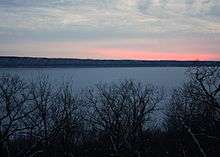Lake Pepin
| Lake Pepin | |
|---|---|
|
Lake from the Minnesota side | |
| Location |
Goodhue / Wabasha counties in Minnesota and Pepin County, Wisconsin |
| Coordinates | 44°29′54″N 92°18′05″W / 44.4982°N 92.3013°WCoordinates: 44°29′54″N 92°18′05″W / 44.4982°N 92.3013°W |
| Primary inflows | Mississippi River |
| Primary outflows | Mississippi River |
| Basin countries | United States |
| Surface area | 45.7 sq mi (118 km2) |
| Average depth | 21 ft (6.4 m) |
| Max. depth | 60 ft (18 m) |
| Frozen | winter |
| Settlements | Lake City, Bay City, Pepin, Maiden Rock, Stockholm, Maple Springs, Camp Lacupolis, Reads Landing |
Lake Pepin is a naturally occurring lake, and the widest naturally occurring part of the Mississippi River, located approximately 60 miles downstream from Saint Paul, Minnesota. It is a widening of the river on the border between Minnesota and Wisconsin. The formation of the lake was caused by the backup of water behind the sedimentary deposits of the Chippewa River's delta. It has a surface area of about 40 square miles (100 km2) and an average depth of 21 feet (6.4 m),[1] which makes it the largest Lake on the entire Mississippi River.
The wide area of the lake stretches from Bay City, Wisconsin, in the north, down past Pepin, Wisconsin, and Reads Landing, Minnesota, in the south, with Pepin being just upstream from where the Chippewa River enters the Mississippi. The villages of Maiden Rock and Stockholm border on the Wisconsin side, while Frontenac State Park takes up a large part of the Minnesota side. The largest city on the waterfront is Lake City, Minnesota.
There are three marinas on the lake: the Lake City Marina, and Hansen's Harbor, both in Lake City, and Dan's Pepin Marina in Pepin, Wisconsin. There is also a private dock for the customers of the Pickle Factory restaurant in Pepin. In the winter, there are ice roads that cross the lake.
Maiden Rock, on Lake Pepin, is one site said to be the locale where a Dakota woman named Winona leapt to her death.[2][3]
History
The lake was first named in a map of New France made by Guillaume Delisle at the request of Louis XIV of France in 1703. The lake was named for Jean Pepin who settled on its shores in the late 1600s after exploring the Great Lakes from Boucherville.
Nicolas Perrot erected the first of a number of fur trade posts, Fort Saint Antoine, in 1686. In 1727 René Boucher de La Perrière and Michel Guignas built Fort Beauharnois on the lake. In 1730 it had to be rebuilt on higher ground.[4] Boucher was the military leader and Father Guignas was a missionary to the Sioux.
In 1890 it was the site of one of the worst maritime disasters on the Mississippi, known as the Sea Wing disaster when the Sea Wing ferry capsized in a bad storm, killing 98 people.[5]
In 1922, Lake City native Ralph Samuelson invented the sport of water skiing on the lake. Ever since that date, Lake City has been known as "the birthplace of waterskiing." The city celebrates with a festival called Waterski Days every year on the last weekend in June.[6][7]
The lighthouse at the entrance to the Lake City Marina is the only working lighthouse on the entire Mississippi River.
Popular culture
Lake Pepin is the lake that Laura and her family visit in the "Going to Town" chapter of Little House in the Big Woods, the first book in Laura Ingalls Wilder's Little House series. Laura's family and their covered wagon then cross the frozen Lake Pepin in the chapter "Going West", the first chapter of the second book, Little House on the Prairie.
As with many other lakes, this lake is also the site of alleged sightings of a monster similar to the one said to live in Loch Ness.
Ecology


Lake Pepin's natural flora are threatened by the increased rates of sedimentation from upstream sources, leading The Lake Pepin Legacy Alliance to call the phenomenon a "wet desert." The lake is filling in at a rate of ten times greater than pre-colonization, due largely to increased run-off from farms along the Minnesota River.[8]
References
- ↑ "Lake Pepin Minnesota DNR".
- ↑ Porter, Cynthya (Feb 1, 2009). "Homecoming To Explore Roles Of American Indian Women". Winona Daily News reprinted at Diversity Foundation. Retrieved 21 Oct 2015.
- ↑ Maiden Rock History
- ↑ Quimby, Mrs. Thomas Letter to Ms. Sackett. September 23, 1928 Manuscripts/Notebooks. Minnesota Historical Society, Saint Paul, Minnesota.
- ↑ "Day-long excursion on Lake Pepin turns into one of the deadliest disasters on Upper Mississippi". ECM Publishers. Archived from the original on April 17, 2008. Retrieved 2009-05-08.
- ↑ "Waterski History".
- ↑ "Waterski Days".
- ↑ http://www.lakepepinlegacyalliance.org/news.html
| Wikimedia Commons has media related to Lake Pepin. |